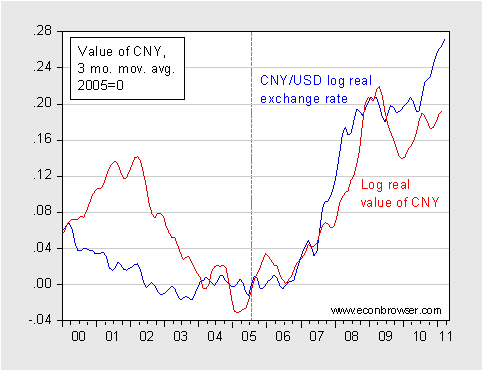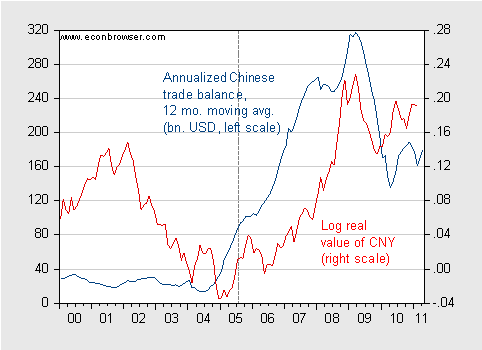The US-China Strategic and Economic Dialog is underway. [0] The topics span many issues. One of the perennials is the yuan’s real value and the Chinese trade balance. Here are two figures.
First, one needs to recall the distinction between bilateral and multilateral real exchange rates.

Figure 1: Log real CNY/USD exchange rate (blue) and log real value of CNY (red), 3 month trailing moving average, both normalized to 2005=0; up is appreciation of the Chinese currency. Dashed line at 2005M07 (China depegs). Source: St. Louis Fed FREDII, IMF IFS, and author’s calculations.
The figure highlights that the CNY is appreciating in real terms (see this post for a discussion of the components due to nominal appreciation and due to inflation). The bilateral appreciation is actually more marked than the multilateral. I think this phenomenon partly reflects the fact that it was becoming increasingly difficult to maintain the previous policy configuration, and (as I observed here) faster appreciation was going to become increasingly harder to resist.
The correlation of the CNY value with Chinese trade balance (with the world) is shown in Figure 2.

Figure 2: Annualized 12 month trailing moving average Chinese trade balance (bn USD) (dark blue), and log real value of CNY (red); up is appreciation of the Chinese currency. Dashed line at 2005M07 (China depegs). Source: St. Louis Fed FREDII, IMF IFS, ADB ARIC, and author’s calculations. [updated 7:45am]
The trade balance has shrunk considerably. How much is due to exchange rate movements is the subject of an ongoing research project, although some results are reported here. The World Bank predicts the 2011 trade balance will be roughly the same in dollar terms, at around $250 billion (so shrinking as a share of GDP), shrinking to around $200 billion, before rising again in 2012 to around $230 billion.[1]
So in my view, some rebalancing is being effected. [2] [3] Whether it’s enough remains to be seen.
I think China would be running a deficit of about $300 billion but for its currency manipulation. That is a big chunk of AD being taken from ROW. And to boot, they have too much, but choose to raise interest rates and reserve requirements instead of allowing their currency to appreciate. This is “behaving badly” in the words of PK.
On top of appreciation, China still has several tools to reduce trade surplus by:
1. rising wages. The min wage for 2011 was raised in between 12-20%;
2. Take back the rebates given for export
Note: The world bank also estimates China’s gain in productivity is average 3% per year for last 10 years.
Does anybody know what percentage of China’s reserves are borrowed ( the foreign currency accumulated not as a result of actual exports and long term FDI but as a result of speculative foreign inflows)?
non: Thanks for sharing.
How effectively are these minimum wage hikes in China actually enforced? Or are these 12-20% minimum wage hikes simply reflecting wage increases in the broader economy?
Anton
Whilst not cumulative econgrapher supplies,a to be estimated breakdown between trade surplus monthly and FDI (hot capital included)
http://econgraphergraphs.blogspot.com/
The hot capital is similar to the rouliers of the medieval age,Capetian era.Soldiers (ties and sparkling shoes) for better fortune on the world map.
The US trade deficit for Mar worsen to $48B. My concern is as prices of products and services imported from China and RoW increase, US import volume does not come down. Higher prices for the imported products and services means a worsening trade deficits for days to come.
The Chinese are not suicidal. They do not want Godmen Sucks, More-gain Stanley, and Just Profits More-gain ramping trillions in hot money and then yanking it overnight.
The communist military generals in Beijing and the Maoist descendent party apparatchiks are not going to allow US, British, German, Swiss, and Dutch supranational firms to gain control of the Chinese banking and financial system.
The Chinese are as greedy as the next human ape, but they are not stupid enough to allow the rentier-oligarchic parasites on Wall St. and the The City of London to take over their banking and financial systems; and if they do allow it, they deserve what they get.
It is weird they wouldn’t first (or at least in conjunction with the controlled appreciation) gradually remove the VAT rebate for exporters. Each percentage point reduction in VAT rebate is equivalent to the same percentage point in currency appreciation. But the advantage is that it won’t encourage hot money inflow since financial players don’t benefit from the reduction in rebate. If you do 1/2 and 1/2 the pressure from speculative inflow will be a lot less. Well let’s invert the thought process. If they don’t follow the obvious approach that leads one to conclude that they actually welcome the speculative inflow. Why? Chinese economy is actually naturally deflationary with productivity gain outstripping demand growth. Inflow helps generate inflationary pressure but is not as inflammatory as trade surpluses. Of course FDI brings other benefits as well.
“It is weird they wouldn’t first (or at least in conjunction with the controlled appreciation) gradually remove the VAT rebate for exporters.”
That would be closely equivalent to allowing the currency to appreciate. The undervalued yuan acts as a uniform subsidy for exports coupled with a uniform tariff on imports. A VAT administered under the destination principle is trade neutral, but failing either to tax imports or to rebate the tax on exports is not. Why use this imperfect substitute for yuan appreciation?
don,
As I said, no financial speculators can benefit from a reduction in VAT rebate. Unlike a slow appreciation it won’t draw in as much hot money flow so won’t cause as much pressure on the domestic monetary system. A combination of the two would be rather ideal in terms of appreciating the RMB while minimizing hot money inflow, if that is what is desired.
China’s demographic structure gives it a bias towards savings. In face of international resistance towards China’s ever larger external savings tax is a better substitute to correct the bias, at least partially, rather than exchange rate. What happened in Japan is a good cautionary tale for the Chinese.